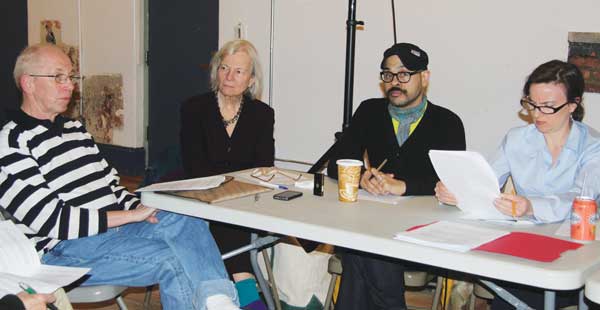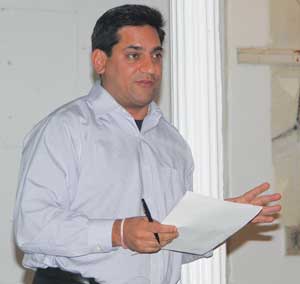 [/media-credit]
[/media-credit]
ALBERT AMATEAU | New York University responded last week to Community Board 2’s questions about the elementary school space proposed for the redevelopment of the south superblock in the N.Y.U 2031 plan.
But members of the board’s Social Services and Education Committee on Mon., Feb. 6, remained unsatisfied and posed objections and further questions.
N.Y.U. has said it was donating land near the southeast corner of LaGuardia Place and Bleecker St., currently occupied by the two-story Morton Williams supermarket, to accommodate a future public school.
The university’s response to a committee request for clarification of the word “donating” mentioned that N.Y.U. purchased the land more than 10 years ago for $23 million.
But Keen Berger, a committee member and public school advocate, told Sayar Lonial, N.Y.U. director of community affairs, “You can have the land and we’ll take the money” — as in the amount of money equal to the value of the land.
Berger proposed that N.Y.U. donate the money, which could be used to convert the state-owned building at 75 Morton St. into a public middle school.
Berger anticipated Lonial’s negative response: that the university’s redevelopment plan, currently undergoing the city’s uniform land use review procedure (ULURP), does not include a possible money swap for development rights.
“We might make it work anyway,” Berger persisted.
Responding to the committee question on whether the university would donate money to the city School Construction Authority, in addition to offering land, to build the core and shell of the proposed school, N.Y.U. gave a flat “No.” The university gave the same “No” to the question of whether students in the school would have access to a proposed belowgrade auditorium and rehearsal space.
The committee also wanted “a true analysis” of how many additional children would come into the neighborhood from the possible 260 new residential units that could be built in the proposed “Zipper Building” if the university choses to create faculty apartments there instead of a hotel.
N.Y.U. noted that the development would introduce about 31 new elementary school students, 10 new middle school students and 16 new high school students to the area by 2031. Children too young for public school and children attending private school are also expected in the faculty housing, but the plan’s draft environmental impact statement does not identify the total number of children, the N.Y.U. response said.
But committee members took issue with the finding that the potential 260 apartments would not have significant adverse impact on local elementary, middle or high schools because the number is below a threshold amount of 310 residential units.
Committee members were also dissatisfied with the university response to questions about the safety of the proposed play area on the roof of the seven-story public school.
“Playgrounds throughout the city are located on the roof spaces of schools and are successful,” was the N.Y.U. response.
That wasn’t enough for committee members. Lois Rakoff, head of the committee, demanded names of specific schools and a definition of the word “successful.” Rakoff also worried about young children having to take an elevator to the playtop area.
“Some children are afraid of elevators,” Rakoff said. “What if an elevator breaks down? What about fire emergencies when elevators are shut down?”
Committee members were still confused about the proposal’s giving the S.C.A. until 2025 to decide on whether to build the school on the Bleecker St. site. The proposed school building would also include three or four stories of student dorms above the school.
Lonial said the plan for the entire building is driven by the S.C.A. action.
“The site will not be built at all until and unless the S.C.A. makes a commitment,” he said. “The dorm cannot float seven stories above the ground.” If the agency chooses not to build a school on the site, Lonial said, N.Y.U. would reserve the right to construct a different as-of-right building for university use — “as of right,” meaning allowed under the location’s current zoning.
However, Chenault Spence, a committee member, and Rakoff insisted that any building on the site should be for community use.
The history of the N.Y.U. school proposal was another issue at the Monday committee meeting.
Teri Cude, a member of the C.B. 2 N.Y.U. Working Group, recalled that at a public news conference in 2010 on the redevelopment plan, Lynne Brown, N.Y.U. senior vice president, said the university’s public school offer was not tied to the approval of the N.Y.U. 2031 plan.
“This sounds like reneging on a promise,” Cude said.
Andrew Berman, executive director of the Greenwich Village Society for Historic Preservation, agreed that N.Y.U. had promised to build the core and shell of a public school not dependent on the ULURP for the 2031 plan.

















